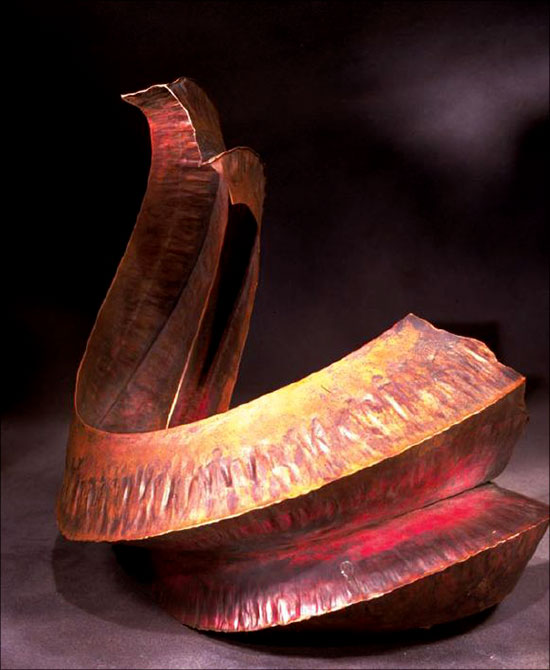Steps on Making a Leaf or Ruffle
This fold is an example of forging on the open side, and introduces how to use hardness dams in foldforming. Dams are work hardened spots, lines, or patterns within the sheet. This form illustrates the way we can use hardness dams to direct the movement of metal under force.
1 Minute Read
This article talks about a fold forming technique called lead or ruffle. Read on on the Steps on Making a Leaf or Ruffle as written by Charles Lewton-Brain.
This fold is an example of forging on the open side, and introduces how to use hardness dams in fold forming. Dams are work hardened spots, lines, or patterns within the sheet. This form illustrates the way we can use hardness dams to direct the movement of metal under force.
| Charles Lewton-Brain Tennessee Foldform II Copper, 24″ by 20″ A large pleated forged-fold. |
Helpful Tip
To avoid water splashing about the shop, I often cool annealed metal by placing it between two large blocks of steel. This is almost as fast as quenching and avoids trapping water in the recesses of the folds.
Purchase your own copy of “Foldforming (Hardcover)” today. |
You assume all responsibility and risk for the use of the safety resources available on or through this web page. The International Gem Society LLC does not assume any liability for the materials, information and opinions provided on, or available through, this web page. No advice or information provided by this website shall create any warranty. Reliance on such advice, information or the content of this web page is solely at your own risk, including without limitation any safety guidelines, resources or precautions, or any other information related to safety that may be available on or through this web page. The International Gem Society LLC disclaims any liability for injury, death or damages resulting from the use thereof.
Charles Lewton-Brain
Master goldsmith Charles Lewton-Brain trained, studied and worked in Germany, Canada and the United States to learn the skills he uses. Charles Lewton-Brain is one of the original creators of Ganoksin.
The All-In-One Jewelry Making Solution At Your Fingertips
When you join the Ganoksin community, you get the tools you need to take your work to the next level.
Trusted Jewelry Making Information & Techniques
Sign up to receive the latest articles, techniques, and inspirations with our free newsletter.
